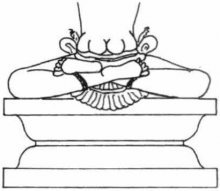Alaya, Ālaya: 32 definitions
Introduction:
Alaya means something in Buddhism, Pali, Hinduism, Sanskrit, Jainism, Prakrit, the history of ancient India, Marathi, Hindi. If you want to know the exact meaning, history, etymology or English translation of this term then check out the descriptions on this page. Add your comment or reference to a book if you want to contribute to this summary article.
Alternative spellings of this word include Alay.
Images (photo gallery)
In Hinduism
Vastushastra (architecture)
Source: Wisdom Library: Vāstu-śāstraĀlaya (आलय) is a Sanskrit technical term denoting a “residence” in general, according to the lists of synonyms given in the Mayamata XIX.10-12, the Mānasāra XIX.108-12 and the Samarāṅgaṇa-sūtradhāra XVIII.8-9, all populair treatises on Vāstuśāstra literature.
Source: OpenEdition books: Architectural terms contained in Ajitāgama and RauravāgamaĀlaya (आलय) refers to “temple or sanctuary §§ 4.2; 5.9.”.—(For paragraphs cf. Les enseignements architecturaux de l'Ajitāgama et du Rauravāgama by Bruno Dagens)
Source: Brill: Śaivism and the Tantric Traditions (architecture)Ālaya (आलय) refers to a “place” (e.g., ‘a place for worship’), according to the Mohacūrottara (verse 4.234-243).—Accordingly, [while describing the construction of the maṭha]—“[...] The installation of the houses is according to the wishes [of the patron]. There should be a [door for] entry and exit to the north. [The houses] may have one, two, or three floors, or as is pleasing. Externally, [the building] is surrounded by a long hall. In the eastern side of the building is the place for worship (yāga-ālaya). One should install the kitchen and so forth as appropriate. [...]”.

Vastushastra (वास्तुशास्त्र, vāstuśāstra) refers to the ancient Indian science (shastra) of architecture (vastu), dealing with topics such architecture, sculpture, town-building, fort building and various other constructions. Vastu also deals with the philosophy of the architectural relation with the cosmic universe.
Purana and Itihasa (epic history)
Source: archive.org: Nilamata Purana: a cultural and literary studyĀlaya (आलय) is the name for a “building” that once existed in ancient Kashmir (Kaśmīra) as mentioned in the Nīlamatapurāṇa.—The terms—bhavana, gṛha, niveśana, ālaya, veśma, āyatana, aṭṭālaka etc. have been used in the Nīlamata for buildings but it is not possible to distinguish between the significance of one term and the other. No example of the period of the Nīlamata has been preserved. The Nīlamata says nothing about the building-materials. All that is known about the houses mentioned in the Nīlamata is that those had doors and ventilators and were whitewashed. The decoration of houses with fruits, leaves and garlands of rice-plants is also referred to.
Source: archive.org: Shiva Purana - English TranslationĀlaya (आलय) or Mandira refers to “one’s house”, according to the Śivapurāṇa 2.2.28. Accordingly as Śiva said to Satī:—“[...] O gentle lady, those who go to another man’s house (para-mandira) without being invited attain disrespect which is more serious than even death. Even the prosperous Indra and people like him going to another man’s house (para-ālaya) in such a context become worthless. What then about others? A journey of such a nature is futile”.
Source: Cologne Digital Sanskrit Dictionaries: The Purana IndexĀlaya (आलय).—Temple for Iśvara.—(see āyatana);1 or a place of residence.2

The Purana (पुराण, purāṇas) refers to Sanskrit literature preserving ancient India’s vast cultural history, including historical legends, religious ceremonies, various arts and sciences. The eighteen mahapuranas total over 400,000 shlokas (metrical couplets) and date to at least several centuries BCE.
Shaktism (Shakta philosophy)
Source: Google Books: Manthanabhairavatantram1) Ālaya (आलय) refers to “core ground” or “abode” (of all manifestation):—[...] Kashmiri Śaiva sources generally understand the sixteen energy to be the New Moon (amākalā). This is followed by the transcendent, seventeenth energy, which is merged in the Heart, the pure ‘I’ consciousness that is the core of reality and the core ground or ‘abode’ (ālaya) of all manifestation. It is within transcendental Śiva dominating all the aspects of His creative and self-delimiting power. It is the energy of consciousness (citkalā) of the absolute (anuttara) and is also called the ‘energy of nectar’ (amṛtakalā).
2) Ālaya (आलय) refers to one of the eight sacred fields (kṣetra), according to the Ṣaṭsāhasrasaṃhitā, an expansion of the Kubjikāmatatantra: the earliest popular and most authoritative Tantra of the Kubjikā cult.—Accordingly, “The man of knowledge should mark the sacred fields located in the towns. [...] Now listen (to how it is) in the home. [...] Starting with the dish in due order, one should not touch these with one's feet, if one wants the best for oneself. One should stay far away from a broom and the wind produced by a winnowing fan. Obstacles (vighna), Siddhas and Yoginīs that have penetrated the wind enter the adept having identified (his) weak spot, and lay hold of the best (within him) for no reason. (The adept) abides in (each) place in the (eight) sacred fields, (namely) Gaṇikā, Śiras, Kālī, Kāla, Ālaya, Śiva, Kāliñjara, and Mahākāla”.

Shakta (शाक्त, śākta) or Shaktism (śāktism) represents a tradition of Hinduism where the Goddess (Devi) is revered and worshipped. Shakta literature includes a range of scriptures, including various Agamas and Tantras, although its roots may be traced back to the Vedas.
Shaivism (Shaiva philosophy)
Source: Brill: Śaivism and the Tantric TraditionsĀlaya (आलय) refers to a “temple (of Śiva)”, according to the 9th-century Sarvajñānottaratantra chapter 18.—Accordingly, “Next, I shall teach the best observance among observances, which is known as the Śiva-vrata and which is revered by Asuras and Gods alike. [...] Next, I shall teach the characteristics of a temple of Śiva (śiva-ālaya), as well as [how to perform] the installation of the liṅga, in which the universe is [itself] ‘installed.’ All the gods, beginning with Brahmā, reside in the liṅga; therefore a Yogin who venerates his guru, God and the fire and who has performed his vidyāvrata should install the liṅga, following the procedure taught in scripture. [...]”.
Source: SOAS University of London: Protective Rites in the Netra TantraĀlaya (आलय) refers to the “receptacle (of mantras)”, according to the Netratantra of Kṣemarāja: a Śaiva text from the 9th century in which Śiva (Bhairava) teaches Pārvatī topics such as metaphysics, cosmology, and soteriology.—Accordingly, [verse 2.22cd-28ab]—“[...] That is supreme strength, that is supreme amṛt. The highest of splendors is highest light of light. The divine Lord is the supreme cause of all the world. The creator, supporter, and destroyer are not as strong as this. This receptacle of mantras (mantra-ālaya—mantrāṇāmālayaḥ hyeṣa) is the word of all perfections and characteristics [...]”.

Shaiva (शैव, śaiva) or Shaivism (śaivism) represents a tradition of Hinduism worshiping Shiva as the supreme being. Closely related to Shaktism, Shaiva literature includes a range of scriptures, including Tantras, while the root of this tradition may be traced back to the ancient Vedas.
In Buddhism
Mahayana (major branch of Buddhism)
Source: academia.edu: A Study and Translation of the GaganagañjaparipṛcchāĀlaya (आलय) refers to “basis”, according to the Gaganagañjaparipṛcchā: the eighth chapter of the Mahāsaṃnipāta (a collection of Mahāyāna Buddhist Sūtras).—Accordingly, “How then, son of good family, does the Bodhisattva relate to the guiding principle of the realm of the dharma, being united with the realm of the dharma? ‘The realm of the dharma’ is the realm that is free from desire since it is free from any impurity; [...] the realm of self since it is originally pure; the realm without personality since it is the highest truth; the realm without information since it is non-abiding; the realm without basis (ālaya) since there is no contamination; the realm without birth since it is fixed; [...]”.

Mahayana (महायान, mahāyāna) is a major branch of Buddhism focusing on the path of a Bodhisattva (spiritual aspirants/ enlightened beings). Extant literature is vast and primarely composed in the Sanskrit language. There are many sūtras of which some of the earliest are the various Prajñāpāramitā sūtras.
General definition (in Buddhism)
Source: Buddhist Door: GlossaryAlaya.—An abbreviation of Alaya vijanana. Alaya is a sort of eternal substance or matter, creative and containing all forms; when considered as a whole, it is non existent, or contains nothing; when considered phenomenal, it fills the universe. It seems to be of the nature of materialism. It is the store or totality of consciousness both absolute and relative. It is described as the fundamental mind consciousness of conscious beings, which lays hold of all the experience of the individual life, and which stores and holds the germs of all affairs. It is the last of Eighth Consciousness from which the Wisdom of Great Round Mirror is derived.
Source: WikiPedia: BuddhismĀlaya (आलय) (Cf. Ālayavijñāna) refers to “that which is clung to”, “adhered to” or “dwelled in”, and is closely connected with bodily existence. Chogyam Trungpa explains that resting in the nature of Ālaya means—going beyond the six sense consciousness, and even beyond the seventh consciousness, the fundamental discursive thought process which brings about the other six. Ālaya consciousness has as its characteristics of being both cause and effect; as cause it perishes and as fruit it is born, it never remains a single entity.
In Jainism
Jain philosophy
Source: archive.org: Anekanta Jaya Pataka of Haribhadra SuriAlāya (अलाय) (Prakrit; in Sanskrit: Alāta) refers to a “fire-brand”, as occurring in the Anekāntajayapatākā-prakaraṇa, a Śvetāmbara Jain philosophical work written by Haribhadra Sūri.—[Cf. Vol. I, P. 155, l. 22]—The Pāiya (Prakrit) equivalent of ‘alāta-cakra’ is ‘alāya-cakka’. It occurs in Visesā (v. 2433). ‘Alātacakra’ means an illusion of a circle generated by quickly revolving a fire-brand (alāta).—Cf. Śrībhāṣya (p. 187).
-
India history and geography
Source: Cologne Digital Sanskrit Dictionaries: Indian Epigraphical GlossaryĀlaya.—cf. ālai (SII 3), a temple; a contraction of dev-ālaya. Cf. āyatana, bhavana, pura, etc. Note: ālaya is defined in the “Indian epigraphical glossary” as it can be found on ancient inscriptions commonly written in Sanskrit, Prakrit or Dravidian languages.

The history of India traces the identification of countries, villages, towns and other regions of India, as well as mythology, zoology, royal dynasties, rulers, tribes, local festivities and traditions and regional languages. Ancient India enjoyed religious freedom and encourages the path of Dharma, a concept common to Buddhism, Hinduism, and Jainism.
Languages of India and abroad
Pali-English dictionary
Source: BuddhaSasana: Concise Pali-English DictionaryĀlaya (m.) 1. abode; roosting place; 2. desire; attachment; 3. pretence.
Source: Sutta: The Pali Text Society's Pali-English DictionaryĀlaya, (m. & nt.) (cp. Sk. ālaya, ā + lī, līyate, cp. allīna & allīyati, also nirālaya) — 1. orig. roosting place, perch, i. e. abode settling place, house J.I, 10 (geh°); Miln.213; DhA.II, 162 (an° = anoka), 170 (= oka). — 2. “hanging on”, attachment, desire, clinging, lust S.I, 136 = Vin.I, 4 (°rāma “devoted to the things to which it clings” K. S.); Vin.III, 20, 111; S.IV, 372 (an°); V, 421 sq. (id.); A.II, 34, 131 (°rāma); III, 35; It.88; Sn.177 (kām° = kāmesu taṇhā-diṭṭhi-vasena duvidho ālayo SnA 216), 535 (+ āsavāni), 635; Nett 121, 123 (°samugghāta); Vism.293 (id.), 497; Miln.203 (Buddh °ṃ akāsi?); DhA.I, 121; IV, 186 (= taṇhā); SnA 468 (= anoka of Sn.366). — 3. pretence, pretext, feint (cp. BSk. ālaya M Vastu III, 314) J.I, 157 (gilān°), 438; III, 533 (mat°); IV, 37 (gabbhinī); VI 20, 262 (gilān°). (Page 109)

Pali is the language of the Tipiṭaka, which is the sacred canon of Theravāda Buddhism and contains much of the Buddha’s speech. Closeley related to Sanskrit, both languages are used interchangeably between religions.
Marathi-English dictionary
Source: DDSA: The Molesworth Marathi and English Dictionaryālaya (आलय).—n S A house, a dwelling, a receptacle, a place of receiving and containing.
Source: DDSA: The Aryabhusan school dictionary, Marathi-Englishālaya (आलय).—n A house.
Marathi is an Indo-European language having over 70 million native speakers people in (predominantly) Maharashtra India. Marathi, like many other Indo-Aryan languages, evolved from early forms of Prakrit, which itself is a subset of Sanskrit, one of the most ancient languages of the world.
Sanskrit dictionary
Source: DDSA: The practical Sanskrit-English dictionaryAlaya (अलय).—a. [nāsti layaḥ avasthānaṃ yasya]
1) Houseless, vagrant, moving about; Śiśupālavadha 4.57.
2) Without destruction or loss, imperishable.
-yaḥ 1 Non-destruction, permanence.
2) Birth, production.
--- OR ---
Ālaya (आलय).—[ālīyate'smin, ālī-ac]
1) An abode, a house, a dwelling; आलयं देवशत्रूणां सुघोरं खाण्डवं वनम् (ālayaṃ devaśatrūṇāṃ sughoraṃ khāṇḍavaṃ vanam) Mahābhārata (Bombay) 1.223.75; न हि दुष्टात्मनामार्या निवसन्त्यालये चिरम् (na hi duṣṭātmanāmāryā nivasantyālaye ciram) Rām.; सर्वाञ्जनस्थानकृतालयान् (sarvāñjanasthānakṛtālayān) Rām. who lived or dwelt in Janasthāna.
2) A village; मन्दरस्य च ये कोटिं संश्रिताः केचिदालयाः (mandarasya ca ye koṭiṃ saṃśritāḥ kecidālayāḥ) Rām.4.4.25.
3) A receptacle, seat, place; हिमालयो नाम नगाधिराजः (himālayo nāma nagādhirājaḥ) Kumārasambhava 1.1; so देवालयम्, विद्यालयम् (devālayam, vidyālayam) &c; fig. also; दुःख° (duḥkha°) Bhagavadgītā (Bombay) 8.15; गुण° (guṇa°).
4) Contact.
-yam ind. Till destruction, death; पिबत भागवतं रसमालयम् (pibata bhāgavataṃ rasamālayam) Bhāg.
Derivable forms: ālayaḥ (आलयः).
See also (synonyms): ālayam.
Source: Cologne Digital Sanskrit Dictionaries: Edgerton Buddhist Hybrid Sanskrit DictionaryĀlaya (आलय).—m., rarely nt. (in Sanskrit ‘home’, also in [Buddhist Hybrid Sanskrit]; Pali id., same mgs. as [Buddhist Hybrid Sanskrit]): (1) (habitation, hence) firm basis, fundamental base, in an-ālaya, ālaya-vijñāna, qq.v. for Tibetan; also Laṅkāvatāra-sūtra 374.3 mano hy ālayasaṃbhūtaṃ, 4 ālayāt sarvacittāni pravartanti taraṅgavat (in both of these substantially = ālaya-vijñāna); perhaps here also Avadāna-śataka ii.175.2—3 tatas tena bhagavato 'ntike cittaṃ prasāditaṃ teṣāṃ ca mahāśrāvakāṇām ālayasamāpannānām (arrived at the fundamental basis, the proper mental state?); (2) attach- ment, clinging: Mahāvyutpatti 5382 kāmālayaḥ, attachment (Tibetan zhen pa) to desires (Tibetan ḥdod pa la); Mahāvastu iii.314.2 (mss. corrupt, ed. incorrect; read) ālayārāmā…ālayaratā ālayasamuditā (prajā), mankind takes pleasure, joy, delight in attachment (to lusts; see samudita, and Pali parallels SN i.136.11 ff.; Vin. i.4.35 ff.); Mahāvastu iii.400.3 hitvā ālayāni (em., from Pali Sn 535; mss. ālepati); Udānavarga xii.18 ālayāṃs trīn (= the three tṛṣṇā 2 = Pali taṇhā; compare Sn 635 ālayā, commentary taṇhā); Mahāvastu iii.200.11 ālayasamudghāto, rooting out of attachment, compare Pali Aṅguttaranikāya (Pali) ii.34.24; Vism. 293.9, 25 f. See also nirālaya.
Source: Cologne Digital Sanskrit Dictionaries: Shabda-Sagara Sanskrit-English DictionaryAlaya (अलय).—mfn.
(-yaḥ-yā-yaṃ) Houseless, homeless. E. a neg. and laya place of refuge.
--- OR ---
Ālaya (आलय).—m.
(-yaḥ) A house, a dwelling, a receptacle, an asylum. E. āṅ before līṅ to enfold, ghañ aff.
Source: Cologne Digital Sanskrit Dictionaries: Benfey Sanskrit-English DictionaryĀlaya (आलय).—i. e. ā-lī + a, m. and n. ([Rāmāyaṇa] 5, 23, 31), 1. A house. 2. A seat.
--- OR ---
Alaya (अलय).—I. m. nondestruction, duration, [Rāmāyaṇa] 3, 71, 10. Ii. adj. without a fixed abode, [Śiśupālavadha] 4, 57.
Alaya is a Sanskrit compound consisting of the terms a and laya (लय).
Source: Cologne Digital Sanskrit Dictionaries: Cappeller Sanskrit-English DictionaryĀlaya (आलय).—[masculine] ([neuter]) dwelling, house.
Source: Cologne Digital Sanskrit Dictionaries: Monier-Williams Sanskrit-English Dictionary1) Alaya (अलय):—[=a-laya] m. (√lī), non-dissolution, permanence, [Rāmāyaṇa iii, 71, 10] ([varia lectio] an-aya)
2) [v.s. ...] mfn. restless, [Śiśupāla-vadha iv, 57.]
3) Ālaya (आलय):—[=ā-laya] a See ā-√lī.
4) [=ā-laya] [from ā-lī] b m. and n. a house, dwelling
5) [v.s. ...] a receptacle, asylum, [Rāmāyaṇa; Yājñavalkya; Kathāsaritsāgara etc.]
6) [v.s. ...] (often ifc. e.g. himālaya, ‘the abode of snow.’)
Source: Cologne Digital Sanskrit Dictionaries: Yates Sanskrit-English Dictionary1) Alaya (अलय):—[a-laya] (yaḥ-yā-yaṃ) a. Houseless.
2) Ālaya (आलय):—[ā-laya] (yaṃ) m. A house.
Source: DDSA: Paia-sadda-mahannavo; a comprehensive Prakrit Hindi dictionary (S)Ālaya (आलय) in the Sanskrit language is related to the Prakrit word: Ālaya.
[Sanskrit to German]
Sanskrit, also spelled संस्कृतम् (saṃskṛtam), is an ancient language of India commonly seen as the grandmother of the Indo-European language family (even English!). Closely allied with Prakrit and Pali, Sanskrit is more exhaustive in both grammar and terms and has the most extensive collection of literature in the world, greatly surpassing its sister-languages Greek and Latin.
Hindi dictionary
Source: DDSA: A practical Hindi-English dictionaryĀlaya (आलय) [Also spelled alay]:—(nm) an abode; a dwelling place; a receptacle; asylum.
...
Prakrit-English dictionary
Source: DDSA: Paia-sadda-mahannavo; a comprehensive Prakrit Hindi dictionary1) Alaya (अलय) in the Prakrit language is related to the Sanskrit word: Alaka.
2) Alayā (अलया) also relates to the Sanskrit word: Alakā.
3) Alāya (अलाय) also relates to the Sanskrit word: Alāta.
4) Ālaya (आलय) also relates to the Sanskrit word: Ālaya.
5) Ālaya (आलय) also relates to the Sanskrit word: Ālaya.
Prakrit is an ancient language closely associated with both Pali and Sanskrit. Jain literature is often composed in this language or sub-dialects, such as the Agamas and their commentaries which are written in Ardhamagadhi and Maharashtri Prakrit. The earliest extant texts can be dated to as early as the 4th century BCE although core portions might be older.
Kannada-English dictionary
Source: Alar: Kannada-English corpusĀlaya (ಆಲಯ):—[noun] a building where one generally lives; a house; an abode; a dwelling.
--- OR ---
Āḷaya (ಆಳಯ):—[noun] a building where one generally lives; a house; an abode; a dwelling.
Kannada is a Dravidian language (as opposed to the Indo-European language family) mainly spoken in the southwestern region of India.
Nepali dictionary
Source: unoes: Nepali-English Dictionary1) Ālaya (आलय):—n. 1. house; abode; place; 2. place; site; location;
2) Ālaya (आलय):—suffix. support
Nepali is the primary language of the Nepalese people counting almost 20 million native speakers. The country of Nepal is situated in the Himalaya mountain range to the north of India.
See also (Relevant definitions)
Starts with: Alayacakka, Alayadharma, Alayalakshana, Alayam, Alayana, Alayas, Alayati, Alayavijnana, Alayavinnanam, Alayodbhava.
Ends with (+473): Abhilekhalaya, Adhyakshalaya, Adhyushtavalaya, Adimalaya, Adityalaya, Agalaya, Agasavalaya, Agnipralaya, Agnyalaya, Akalaya, Akandapralaya, Akhandalaya, Akshasutravalaya, Akshavalaya, Alalaya, Amalaya, Amanaskalaya, Amaralaya, Amganavalaya, Amghrivalaya.
Full-text (+169): Devalaya, Agnyalaya, Manasalaya, Alaka, Tridashalaya, Kritalaya, Pramathalaya, Gilanalaya, Bandhanalaya, Dantalaya, Padmalaya, Keshavalaya, Vidyalaya, Himalaya, Alayam, Balalaya, Vetala, Alayas, Alavas, Matalayam.
Relevant text
Search found 51 books and stories containing Alaya, Ālaya, A-laya, Ā-laya, Alayā, Alāya, Āḷaya; (plurals include: Alayas, Ālayas, layas, Alayās, Alāyas, Āḷayas). You can also click to the full overview containing English textual excerpts. Below are direct links for the most relevant articles:
Brihad Bhagavatamrita (commentary) (by Śrī Śrīmad Bhaktivedānta Nārāyana Gosvāmī Mahārāja)
Verse 2.1.141 < [Chapter 1 - Vairāgya (renunciation)]
Verse 1.4.62 < [Chapter 4 - Bhakta (the devotee)]
Verse 1.6.16-18 < [Chapter 6 - Priyatama (the most beloved devotees)]
Early Chola Temples (by S. R. Balasubrahmanyam)
Kailasanathar Temple < [Chapter XIV - Conclusion]
Ashta Parivara Devatas < [Chapter XIII - Prasada: Component Parts]
Pallava < [Chapter XIII - Prasada: Component Parts]
The Great Chariot (by Longchenpa)
Part 1b.1f - How consciousness dissolves < [B. The extensive explanation of the nature of karma]
Part 1b.1a - The support: The explanation of alaya and consciousness < [B. The extensive explanation of the nature of karma]
Part 1b.1j - How the cause of liberation is produced < [B. The extensive explanation of the nature of karma]
Middle Chola Temples (by S. R. Balasubrahmanyam)
Temples in Emapperur < [Chapter II - Temples of Rajaraja I’s Time]
Temples in Dadapuram < [Chapter II - Temples of Rajaraja I’s Time]
Mahamandapa and Mukhamandapa < [Tanjavur/Thanjavur (Rajarajesvaram temple)]
Bhakti-rasamrta-sindhu (by Śrīla Rūpa Gosvāmī)
Verse 1.2.134 < [Part 2 - Devotional Service in Practice (sādhana-bhakti)]
Verse 1.2.225 < [Part 2 - Devotional Service in Practice (sādhana-bhakti)]
Related products




